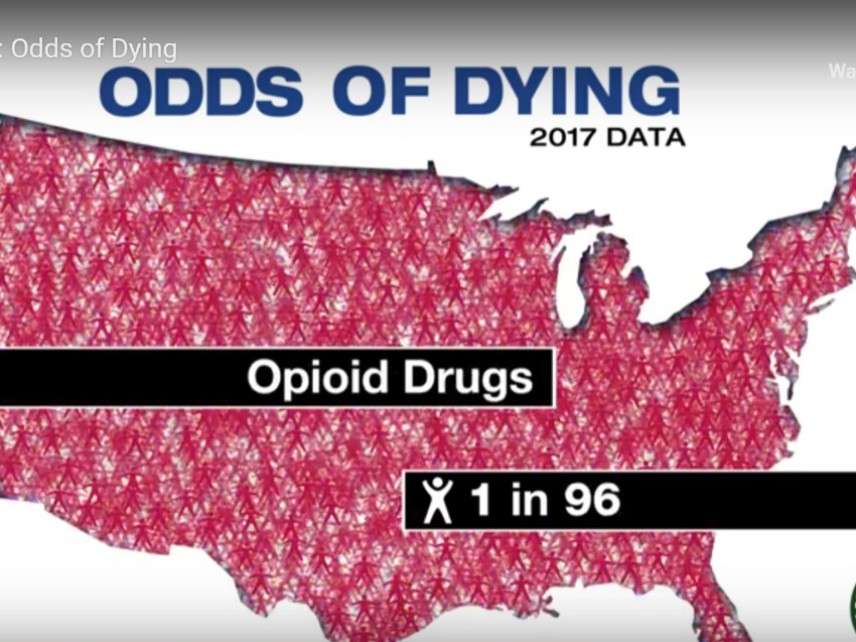Are You More Likely to Be Killed by Opioids Than a Car Crash?
Only if you are using heroin, fentanyl, or dangerous drug mixtures

A report from the National Safety Council (NSC) has prompted a bunch of news stories highlighting the finding that an American's lifetime risk of dying from an accidental opioid overdose is now greater than his lifetime risk of dying in a car crash. "Odds of Dying From Accidental Opioid Overdose in the U.S. Surpass Those of Dying in Car Accident," says the CNN headline, while The New York Times reports that "the opioid crisis in the United States has become so grim that Americans are now likelier to die of an overdose than in a vehicle crash." The NSC itself claims "your odds of dying from an accidental opioid overdose are greater than [your odds of] dying in a motor vehicle crash."
All of this is highly misleading for a couple of reasons. First, the danger of dying from opioids, unlike the danger of dying in a car crash, can be readily avoided by most people. Second, the NSC's calculation lumps together different kinds of drug use that pose very different levels of risk, ranging from substantial to negligible.
As Josh Bloom notes at the American Council on Science and Health's blog, journalists "feel the need to compare opioid overdose deaths to those from automobile accidents, as if the two have anything to do with each other." Bloom wonders what sort of conclusion we are supposed to draw from this ranking: that arranging more fatal car crashes would alleviate the "opioid crisis"? He also notes that treating "opioid overdoses" as a single cause of death conflates heroin and illicit fentanyl, which are involved in the vast majority of such cases, with prescription pain medication, which accounts for a small share that looks even smaller once you take drug mixtures into account.
The records compiled by the U.S. Centers for Disease Control and Prevention (CDC) indicate that heroin or illicit fentanyl was involved in 75 percent of the 47,600 opioid-related deaths that the CDC counted in 2017. Just 30 percent of opioid-related deaths involved prescription analgesics such as hydrocodone and oxycodone, and about two-fifths of those cases also involved heroin or fentanyl.
Adding more substances to the analysis shows that most records listing a prescription pain reliever also list other drugs: For example, 68 percent of deaths involving prescription opioids in 2017 also involved heroin, fentanyl, cocaine, barbiturates, benzodiazepines, or alcohol. In other words, less than 10 percent of opioid-related deaths involved pain medication by itself, and the actual percentage may be considerably lower, since coroners and medical examiners do not always note additional drugs. In New York City, which has one of the country's most thorough systems for reporting drug-related deaths, 97 percent of them involve mixtures.
Keep these facts in mind when you read that your lifetime risk of dying from an opioid overdose is one in 96, according to the latest NSC calculation, compared to a one-in-103 risk of dying in a car crash. That does not really mean you are more likely to die from an opiod overdose, of course, since you can make sure that will not happen by never taking an opioid. But even if you are brave enough to use pain medication that a doctor prescribes for you, the chance that it will kill you is very small: on the order 0.022 percent a year, according to a 2015 study of opioid-related deaths in North Carolina.
To approximate the risk calculated by the NSC, you'd have to continue taking the same drug every year for half a century or so. But even that is misleading, because these deaths are not random. They are especially likely to occur in people who take larger doses than instructed and who mix opioids with other drugs. If you don't do either of those things, your risk will be even lower.
The illicit opioids are much more dangerous because their potency is highly variable and unpredictable. Furthermore, they are becoming even more dangerous, largely thanks to the proliferation of fentanyl and fentanyl analogs as heroin adulterants and substitutes, which is encouraged by the economics of prohibition. In 2017 that category of opioids was involved in 60 percent of opioid-related deaths, up from 14 percent in 2010.
A rough calculation (one that does not take into account the underrepresentation of heroin users in the government's surveys) indicates there were 17.5 drug-related deaths per 1,000 heroin users in 2017, compared to 1.3 drug-related deaths per 1,000 "misusers" of prescription opioids. That's a big difference, even if the official count of heroin users is off by a factor of two or three, and it's not hard to see how cracking down on pain pills could increase opioid-related deaths by pushing users toward black-market alternatives. Judging from the North Carolina study, the corresponding rate for people who take opioids prescribed for them is something like 0.0022 per 1,000. The NSC's one-in-96 lifetime risk is an average that conflates different situations involving dramatically different odds.
By contrast, while your chance of dying in a car crash depends on factors such as miles traveled, traffic conditions, and seat belt use, anyone who drives or rides is exposed to some risk, and the average gives you an idea of how big the danger is. It is perfectly rational to worry more about dying in a car crash than about dying from opioids, especially if you use them only as directed to treat pain. When the NSC warns us about "the danger inside of a bottle of pills" in the context of a calculation based mainly on illicit opioids, it is engaged in fearmongering rather than public education.


Show Comments (56)